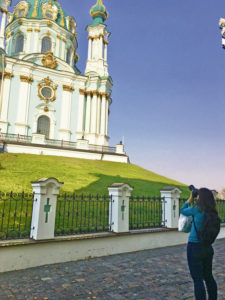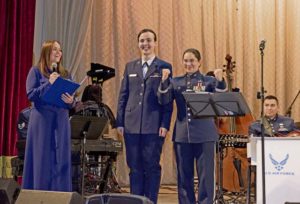
“Where are you from?” Military members often travel to all ends of the earth and meet people from all walks of life. We often get asked that question. People want to know our story, where our roots began.
In May 1994, my parents sought religious refuge in America, because the sanctioned religion was Orthodoxy and my parent’s Baptist faith, along with all others, wasn’t welcome. I had just turned two years old.
As a Ukrainian immigrant growing up in Oregon, I didn’t know how to answer that question. Most of my classmates in school did not know Ukraine was a country, so I would say “I’m Russian.” I spoke Russian, so it was easier to explain. Then, in 2014 the war between Russia and Ukraine began, and I had to pick a side. Was I Russian, Ukrainian, American, or a mixture of all three? How did I see myself, and how did others see me?
In Slavic cultures, a person’s nationality is decided by the father’s nationality. While my parents were both born in what is now independent Ukraine, my mother is Russian through her paternal lineage. I have both countries in me. To complicate the matter, my grandparents from my mother’s side and my father’s side were ethnically Ukrainian and Russian.

Growing up in America, I learned to speak English in school. There was a time when I didn’t know a single English word, so I sat mute in class, hoping the teacher would not notice me. Through the diligent help of interpreters and fellow classmates, I assimilated into American culture. At home however, we spoke a mix of Russian and Ukrainian, ate borsht, and read Russian fairytales. As I began to assimilate at school, my life at home continued to mold me predominately in Slavic culture.
When we left Ukraine, it was an infant country with an uncertain future. Ukraine had been linked with Russia for nearly a millennia, first under the Kievan Rus, then the tsars, followed by the imperial Romanovs, and finally nearly seven decades under the Soviet Union.
Strict codes of ethics and behavior were enforced by Moscow over the centuries, especially through a common language — Russian. Ethnic Ukrainians were considered inferior, and the Soviet government implemented a program to change the demographic makeup of the region. During this genocide, known as the Holodomor, the Soviet government transplanted Russian colonists into the region to displace native Ukrainians, and further reduced the native population through a program of targeted famine.
On Aug. 24, 1991, Ukraine gained its independence, and soon fifteen other countries joined in establishing their own governance. The Soviet Union dissolved just four months later.
Those first several years after the collapse of the Soviet Union were ones of upheaval for many people. Many survived as best as they could.
In the 2010s, the Ukrainian government was working on building closer relations with the West, which strained their relationship with Russia. The president at the time, Viktor Yanukovych, preferred to work with Ukraine’s neighbor to the east. His actions pushed approximately 400,000-800,000 people to protest in the “Euromaidan” movement. It is estimated that over 700 people died or disappeared as a result of their involvement in the protests.
Yanukovych asked Russia for assistance, and when the tides turned against him he fled to Moscow. In response, the Ukrainian Parliament relieved him of his duties as President. In March 2014, the Ukrainian region of Crimea, which is primarily populated by pro-Yanukovych supporters, was illegally annexed by Russia. This led to the Russian military invasion of Ukraine’s eastern regions and the War in Donbass, which continues to this day.
This year, from Oct.9-20, I received an incredible opportunity to travel with the U.S. Air Forces in Europe Ambassador’s Jazz Band as a photojournalist documenting their “Music of Freedom” tour across Ukraine. We started our journey in Lviv, then traveled to Ivano-Frankivsk, Chernivtsi, Vinnytsia, Desna, and ended our trip in Kyiv. The USAFE Band traveled across the country with the Ukrainian National Presidential Orchestra, and performed with many musicians along the way. The meticulously planned tour combined songs that represented American and Ukrainian cultures. Every concert would begin with the state anthem of Ukraine, “Ще не вмерла Україна,” (“Ukraine Shall Not Perish”) and the national anthem of the United States, “The Star-Spangled Banner.”
Through my camera lens, I captured the joy on people’s faces as the songs ignited a passion in their souls. There were some obvious skeptics in the audience, whose stone-cold faces were motionless for the first few jazz arrangements. As the program progressed, their expressions softened.
Toward the middle of the program, their eyes began to shine. As the program would draw closer toward the encore, they would clap wildly and their faces illuminated a complete change of heart.
This was the first time I stepped on Ukrainian soil in 25 years. Traveling with the USAFE Jazz Band and sharing the universal language of music with the people of Ukraine is something I will never forget. The human connections that transcend borders and oceans, unite us into one human race, which hopes for a better future for all. It did not matter that we spoke a different language, music is a universal language that gives hope and brings tears to hardened hearts.
So, where am I from? I am a Russian-speaking Ukrainian-American from planet Earth. Our languages may be different, but our hope for a better future for all makes us one.


